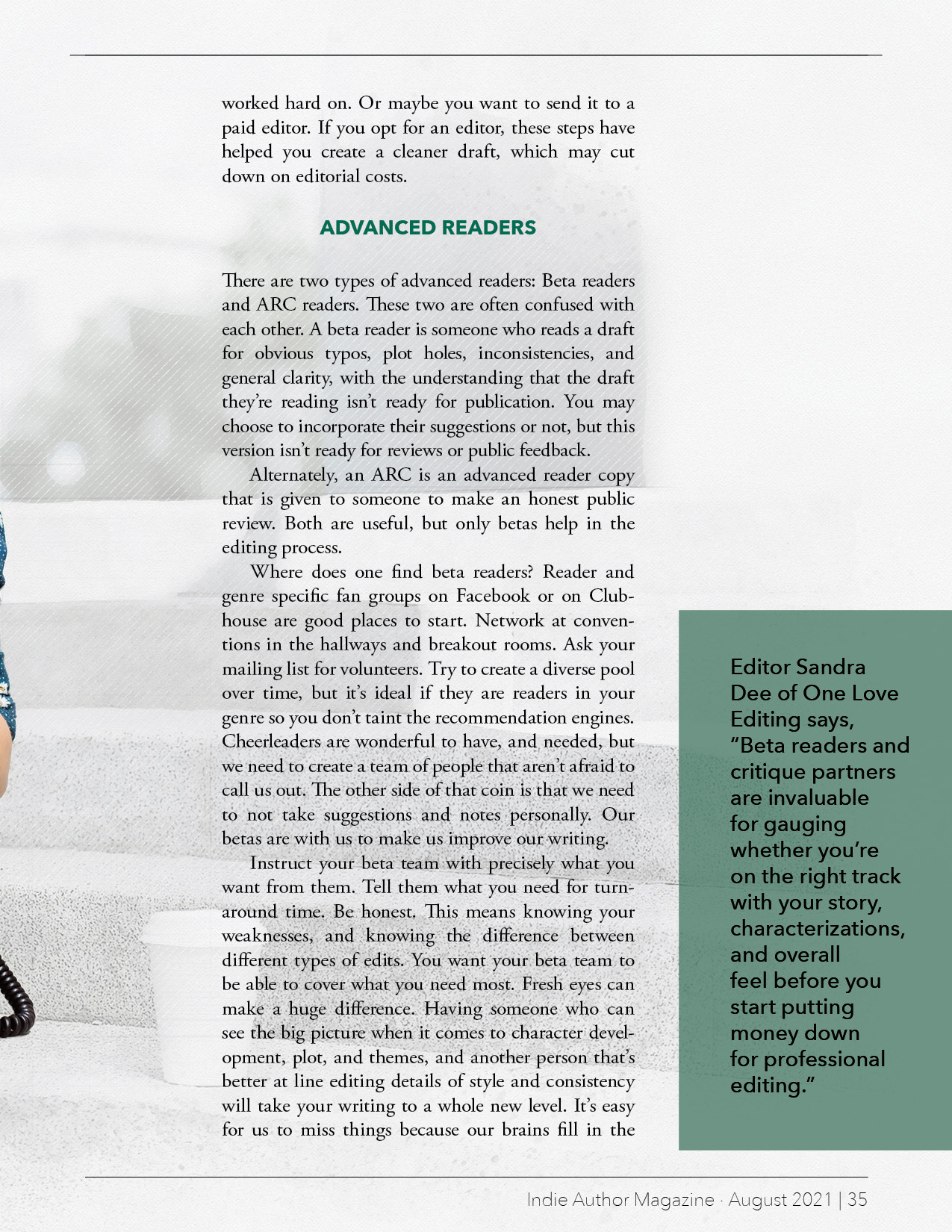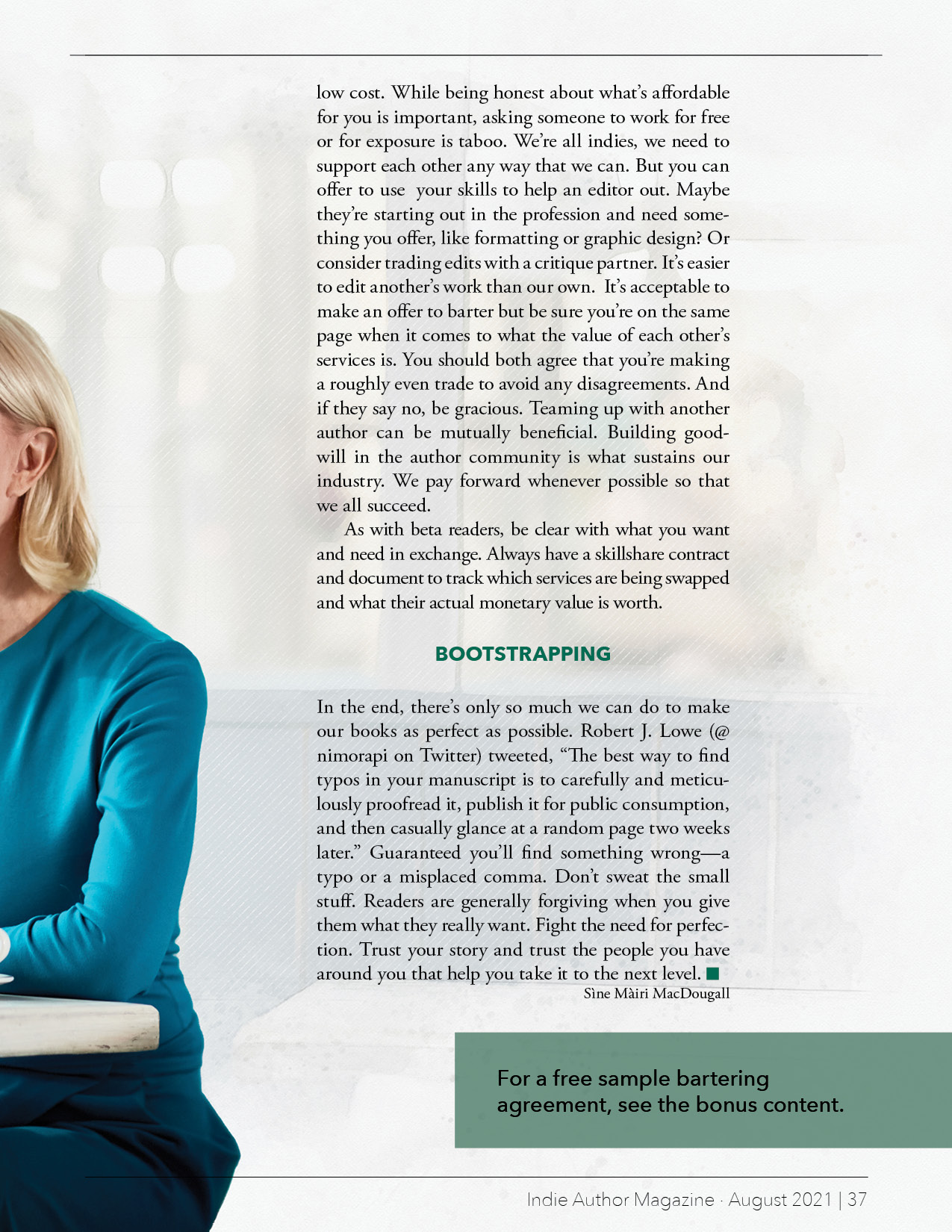When and Where to Spend Your Limited Resources
What if we told you that your book doesn’t need to be perfect to be published? Following the Michael Anderle school of thought, the goal is to hit a MVP—minimum viable product—with our books. We want to write to genre expectations; it’s the story and characters that lead to people binge-reading our novels. Errors are tolerated as long as we hit tropes and have the story development that our readers are addicted to. But this doesn’t mean throwing our first draft up on Amazon and hoping for the best.
Self-Editing
We get out of this what we put into it. While the gold standard is to always use an editor (or several), there are ways to cut back on how many or what type you need. Self-editing is a great place to start refining your story on your own.
- Read-through: This works best when you export your working file to your e-book file type of choice or if you go old school and print it all out. The point is to give your brain a visual cue that you’re no longer drafting, you’re now editing. You can highlight, circle, and make notes to your heart’s content. Another fun read-through option is to have an app or your word processor’s AI read you the draft. If you’ve never heard a romance scene read by Microsoft Word, trust us and do it. It’s hilarious and endlessly entertaining. More importantly, hearing what’s written makes it easier to pinpoint things that don’t sound right developmentally.
- Reverse-outlining: Make a running synopsis of all the scenes you have written and plug them into a story arc structure of your choice. Seeing what you have and where it fits can reveal any blatant plot holes. Once you have plugged your scenes into a new structure, compare it to your original outline. Perhaps there’s something in the original that you’ve missed or need to develop more. Or you may find new gems that need more polish.
- Editing software: Some are free web-based while others are subscriptions. Check out this month’s tech article for a deep dive into finding the best option for you. These programs scan for clarity, grammatical errors, inconsistent tenses, and overused words. Be cautious if using more than one of these programs. They don’t always agree, and you can add commas with one to have the other undo them all. Pick one program and stick to it so any remaining errors are consistent.
With a revised draft tidied up to the best of your ability, it’s time to decide whether you’re going to publish your draft that you have worked hard on. Or maybe you want to send it to a paid editor. If you opt for an editor, these steps have helped you create a cleaner draft, which may cut down on editorial costs.
Advanced Readers
There are two types of advanced readers: Beta readers and ARC readers. These two are often confused with each other. A beta reader is someone who reads a draft for obvious typos, plot holes, inconsistencies, and general clarity, with the understanding that the draft they’re reading isn’t ready for publication. You may choose to incorporate their suggestions or not, but this version isn’t ready for reviews or public feedback.
Alternately, an ARC is an advanced reader copy that is given to someone to make an honest public review. Both are useful, but only betas help in the editing process.
Where does one find beta readers? Reader and genre specific fan groups on Facebook or on Clubhouse are good places to start. Network at conventions in the hallways and breakout rooms. Ask your mailing list for volunteers. Try to create a diverse pool over time, but it’s ideal if they are readers in your genre so you don’t taint the recommendation engines. Cheerleaders are wonderful to have, and needed, but we need to create a team of people that aren’t afraid to call us out. The other side of that coin is that we need to not take suggestions and notes personally. Our betas are with us to make us improve our writing.
Instruct your beta team with precisely what you want from them. Tell them what you need for turnaround time. Be honest. This means knowing your weaknesses, and knowing the difference between different types of edits. You want your beta team to be able to cover what you need most. Fresh eyes can make a huge difference. Having someone who can see the big picture when it comes to character development, plot, and themes, and another person that’s better at line editing details of style and consistency will take your writing to a whole new level. It’s easy for us to miss things because our brains fill in the backstory for us. Betas will ask you to elaborate plot points. Follow those up with someone good at proofreading to hunt down final typos and wonky cut and paste formatting. Et Voila! You have a solid support system. Acknowledging your beta team in your author’s note is a nice way to show your appreciation of them.
Editor Sandra Dee of One Love Editing says, “Beta readers and critique partners are invaluable for gauging whether you’re on the right track with your story, characterizations, and overall feel before you start putting money down for professional editing.” Having these additional eyes on your story can really help both you and your editor, should you choose to engage one.
Bartering
If you decide that even after all your self-edits and amazing work from your beta team that you still need an editor, there are ways to keep that at low cost. While being honest about what’s affordable for you is important, asking someone to work for free or for exposure is taboo. We’re all indies, we need to support each other any way that we can. But you can offer to use your skills to help an editor out. Maybe they’re starting out in the profession and need something you offer, like formatting or graphic design? Or consider trading edits with a critique partner. It’s easier to edit another’s work than our own. It’s acceptable to make an offer to barter but be sure you’re on the same page when it comes to what the value of each other’s services is. You should both agree that you’re making a roughly even trade to avoid any disagreements. And if they say no, be gracious. Teaming up with another author can be mutually beneficial. Building goodwill in the author community is what sustains our industry. We pay forward whenever possible so that we all succeed.
As with beta readers, be clear with what you want and need in exchange. Always have a skillshare contract and document to track which services are being swapped and what their actual monetary value is worth.
Bootstrapping
In the end, there’s only so much we can do to make our books as perfect as possible. Robert J. Lowe (@nimorapi on Twitter) tweeted, “The best way to find typos in your manuscript is to carefully and meticulously proofread it, publish it for public consumption, and then casually glance at a random page two weeks later.” Guaranteed you’ll find something wrong—a typo or a misplaced comma. Don’t sweat the small stuff. Readers are generally forgiving when you give them what they really want. Fight the need for perfection. Trust your story and trust the people you have around you that help you take it to the next level.
Sìne Màiri MacDougall






